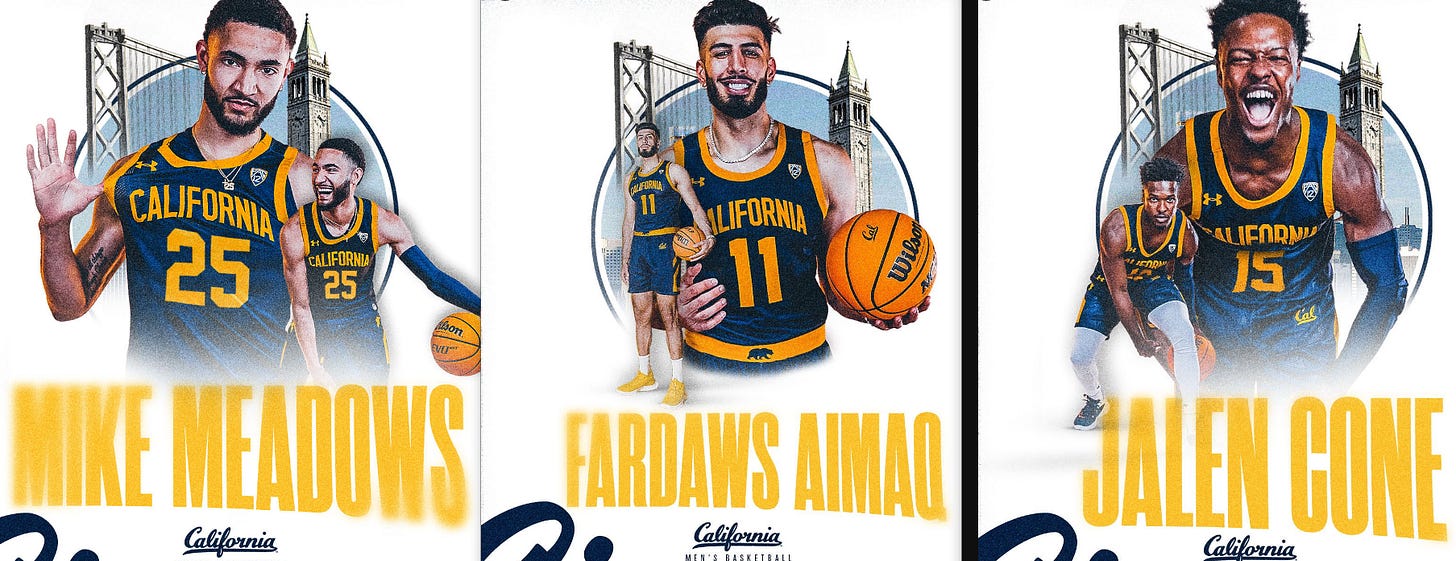Cal Embraces the Transfer Portal
The sea change in recruiting strategy for football and basketball marks an important milestone for Cal athletics, but is it a long term strategy or a one year necessity?
Just a month ago, following Cal’s hire of Mark Madsen, I wrote the following:
Potential huge con: Has Cal’s transfer deficit been a failure of Cal’s previous coaches, or a failure of Cal’s administration making admission either as an undergraduate transfer or as a grad student so cumbersome that Cal can only take the occasional academically minded/Ivy league kinda dude?
My concern at the time: Cal, historically, has not done well via the transfer portal. While there have certainly been examples of successful and popular Golden Bears arriving on campus via transfer from other schools or the JC level, Cal tended to lose more talent than it gained. The fear was that such a state of affairs was baked into Cal’s academic side of the house: by putting in place high academic standards, current Cal students would be well positioned to leave Cal for anywhere else, while prospective transfers would not be able to gain entry into Cal due to grades, non-transferrable credits, lack of viable grad programs, or any number of other potential logistical hurdles.
And in the month since, both Cal basketball AND Cal football have gone about proving my fears unfounded.
Cal football currently has brought in a (to my knowledge) unprecedented-for-Cal 16 transfers and is actively going after more. And the additions haven’t been a bunch of rotational depth or developmental additions - there are players that you would expect to compete at pretty much every position group on both sides of the ball. Of the 16 players added, 12 came from other P5 programs and all come from D1 programs. Almost every player added either already received significant playing time, or is a younger player with significant recruiting pedigree. Both in size and scope this is major shift in roster building strategy for Cal football generally and Justin Wilcox specifically.
Meanwhile, Cal basketball has already brought on four transfers in just the last month with multiple other players offered and more commits likely to come. The speed with which Mark Madsen has remade his roster has shocked me, even knowing that he was a skilled transfer portal practitioner at Utah Valley. This may not be the biggest roster transformation in Cal basketball history, but it is certainly the biggest roster transformation driven by transfers in Cal basketball history.
There are clearly two things at play right now fueling Cal’s portal success, both of which bode well for the future:
Cal athletics and Cal admissions are working together to get transfers admitted rather than finding ways to reject candidates. I don’t have any inside information info into what, if anything, has changed. Maybe a decade of improving athletics academic numbers have convinced the campus at large to give athletics a little more grace. Maybe Cal took a look at the reality of modern athletics and decided that they weren’t going to voluntarily disarm. Whatever the reason, whatever the shift, based on the volume and speed with which Cal has added transfers, admissions is no longer a significant roadblock.
Cal has a unified, competent, well-funded NIL program. Some schools have NIL collectives run by incompetent boosters, others have competing NIL collectives, others are poorly funded. Currently, none of those concerns apply to Cal Legends, and the result is that Cal has been competitive in the transfer portal in both major sports.
The obvious question: is this degree of roster building via transfer the new normal, or a one-year matter of circumstance? Is it the best way to build competitive programs at Cal?
You can see why this might not be a typical year for either revenue sport. For Cal football, the Bears struggled badly in high school recruiting, then turned over their offensive coaches. That plus a solid number of guys with extra COVID years finally moving on meant that there was more space on the roster than usual, and a sudden need for personnel, particularly on the offensive side of the ball.
For Cal basketball . . . well, when an older roster goes 3-28, lots of guys aren’t going to stick around and a major rebuild is all but certain, and sure enough Mark Madsen ended up inheriting only 5 returning scholarship players and 2 incoming recruits.
It’s hard to imagine that Justin Wilcox and Mark Madsen won’t want to start making a dent in the high school recruiting scene, and if Cal Legends can support Cal’s recruiting efforts via transfer, I would imagine they can do the same for high school recruits.
On the other hand, if both programs experience immediate on-field improvements thanks to a sudden infusion of experienced talent, maybe both Madsen and Wilcox will find that a very different brand of roster building can indeed work year after year in Berkeley, in a way that many might not have thought possible even a year ago.



Nice job, Nick. It is also worth noting that the women's basketball team has done well in the portal, after losing Curry and Bonner they've added Marta Suarez from Tennessee, Ila Lane from UCSB, Ionna Krimili from USF and McKayla Williams from Gonzaga all of whom look like they can be key contributors to the '23-24 squad.
Obviously we can't go back to the days where Cal was flirting with academic sanctions but the reality can't be avoided. We need to win. Players should be able to pass their classes but I fully support using athletic ability to offset academic requirements in admissions.
If a player can't hack the work despite reasonable assistance by the university then the player can transfer. But if they can, then we made a good admission investment. The portal cuts both ways and, realistically, we should be giving a broader swath of people the chance to earn a Cal degree.